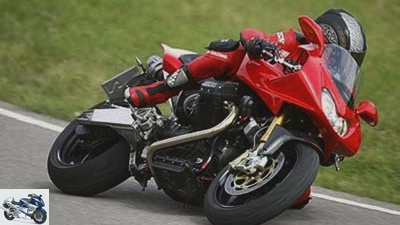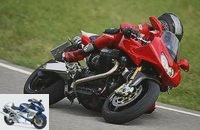Menus

Test Moto Guzzi MGS-01 Corsa
Please copy it!
Moto Guzzi dealer Hokenschnieder has done it: He is bringing the racing Guzzi MGS-01 Corsa onto the road. One can only advise the Guzzi factory: do it, but please quickly. A test of the strongest Moto Guzzi of all time.
What a sight! What an engine! What an interplay of noble carbon laminate, polished aluminum, tarnished stainless steel and coarse cast that appears to have been carved out of the solid: The MGS-01 enchants the Italo fan, who has not been spoiled lately, with wonderful shapes and colors. Sure, Rosso has to be the fairing, Oro the spring elements and brakes and Nero the engine. Nothing should cover it, and at the back, on the sexy shaped rear, start number fields must be indicated. Then that fits.
In times when athletes shamefully cover water-cooled engines under glaring plastic, the Guzzi sends a clear message: I am an engine. With wheels on, but only as much as you need to sit on and protect yourself from the wind. Basta. The motor. The starter panted on the starter ring gear for an excruciatingly long time. At the last moment the 1200 V2 rumbles off, turns at 2000 rpm and shakes the world. Nobody would suspect a motorcycle engine just listening. More like a propeller fighter pilot shortly before the mission. That impresses. Just like clutching the clutch and driving off. The dry clutch hisses, the hand lever needs strength, the two-cylinder revs up nervously and tilts the machine to the right. You have to get used to it. It makes sense that the most powerful air-cooled V2 engine in the world doesn’t purr like a kitten when it comes to purring its neck. But does he have to hammer so terribly that one is afraid and afraid? He must. In third gear at the latest, it becomes clear: This is a real “bang,” into which a huge amount of mixture is sucked into canister-sized combustion chambers, heavily compressed and then torched in style with double ignition. This is irritating because it is rude and nasty.
But: Thanks to the good coordination of the injection and ignition, mechanically directly coupled throttle valves of the two intake tracts and a fair amount of flywheel, the M.Maneuver oto Guzzi MGS-01 through the dense city traffic. And you don’t even have to be ashamed of the quiet noises from the monopot under the stern. It’s plugged to a 35-millimeter passage, with both cylinders breathing through 50-millimeter throttle valves. If that works out?
It works. At least 124 hp and 114 Nm balances the Mandello hammer in road trim on the six-speed gearbox. That’s enough to accelerate to 200 km / h in 10.7 seconds and for a top speed of 251 km / h. Can 600s today too? No matter. How it depends. Nobody will notice whether he is 200 km / h in 10.7 seconds or 9.9 seconds. That only pulls a little more on the arms. On the Guzzi, however, he will register every blow, every single combustion process that drives him forward. A four-cylinder driver can never experience this coarse tearing at 1800 rpm, hate this performance slump at 4000 rpm and fall into euphoria at 5500 rpm. At 8000 rpm he will not slowly get scared for his connecting rod because his barrel organ is only then beginning to pull. The Guzzi shoots its soul out of the cylinders in this area. And that’s really enough for public roads.
The landing gear. What does chassis actually mean? Driving tools could be reinterpreted. Fits wonderfully. How to sit. Almost like on a super sporty Japan thousand. Gathered, handlebars not too deep, tank not too long, footrests not too high, cylinder heads barely in the way. Le Mans drivers know what it’s about. The MGS-01 has everything you need to drive. For really sporty driving. A balanced weight distribution, for example. The engine could be installed very far forward thanks to a special gearbox construction. The frame, lever system for the shock absorber, swing arm mounting, footrests and footbrake lever were attached to the rear gearbox cover. So the Guzzi can carry a long swing arm without increasing the wheelbase infinitely. Together with the torque support of the cardan drive, this calms down when the load changes.
The housing cover is a product of modern computer-controlled milling technology. Made from the full material, it is like a small work of art. Finding out the price of this complex component would be exciting research. At least 1.35 hyosung.
But back to the Guzzi. What else does the sports driver love? Sure, Ohlins. This fork and this shock absorber inspire with a wide adjustment range and the best response. The Brembo radial calipers at the front can be perfectly dosed. So the sports driver doesn’t miss anything. However, he needs a lot of feeling for the poisonous rear brake.
Overall, the Guzzi moves unmoved on its way, willingly to be thrown in an inclined position, if necessary, even in the deepest. You take the next bend with pleasure, enjoy the stability and let the bull of Motor pull out of the bend again. The side stand touches down to the left near the border area, nothing to the right. A somewhat tough steering damper keeps kickback in check, the Guzzi lies like a board even at top speed. There is hardly anything nicer to drive on country roads of any order ?? when you’ve learned to love exotic animals. Because, as described, the engine runs rough and you have to be able to shift gear with such a flywheel-driven engine.
What is missing? Maybe warmer oil, because during the test drives, the engine and oil cooler even cooled the lubricant to below 50 degrees at over 200 km / h on the motorway. The display instrument acknowledges this with hectic warnings. And consideration. The MV mirrors on the fairing conveniently house the indicators, but you can watch
little in it. And money. The MGS-01 costs 28,900 euros in street trim. A lot of money for a motorcycle, but adequate for this fascinating piece of motorcycle engineering.
Buy complete article

Test Moto Guzzi MGS-01 Corsa
Please copy it!
Technical specifications
Engine: air-cooled two-cylinder four-stroke 90-degree V-engine, crankshaft lying lengthways, one camshaft on each side, operated via toothed belt, four valves per cylinder, bumpers and rocker arms, wet-
Sump lubrication, injection, Ø 50 mm, battery 12 V / 11 Ah, hydraulically operated two-disc dry clutch, six-speed gearbox, cardan.
Bore x stroke 100.0 x 78.0 mm
Cubic capacity 1225 cm3
Compression ratio 11.6: 1
rated capacity
94.0 kW (128 PS) at 8000 rpm
Max. Torque 113 Nm at 6200 rpm
Chassis: central tubular frame made of steel, load-bearing motor, upside-down fork, Ø 43 mm, adjustable spring base, rebound and compression damping, two-arm swing arm made of aluminum, central spring strut with lever system, adjustable spring base, rebound and compression damping, double disc brake at the front, Ø 320 mm, Four-piston fixed calipers, rear disc brake, Ø 220 mm, two-
piston fixed caliper.
Cast aluminum wheels 3.50 x 17; 5.50 x 17
Tires 120/70 ZR 17; 180/55 17
Dimensions and weights: wheelbase 1450 mm, steering head angle 66.0 degrees, caster 97 mm, spring travel f / r 120/125 mm, seat height 820 mm, weight with a full tank * 215 kg, tank capacity 18.5 liters.
Two year guarantee
Red color
Price 28,900 euros
Contact Hokenschnieder & Landgrave
33649 Bielefeld
Telephone 0521/452445
www.hoekenschnieder.de
MOTORCYCLE measurements
Performance
Top speed 251 km / h
acceleration
0 100 km / h 3.1 sec
0 ?? 140 km / h 5.3 sec
0 200 km / h 10.7 sec
Draft
60 ?? 100 km / h 5.1 sec
100 ?? 140 km / h 7.0 sec
140 ?? 180 km / h 5.0 sec
Speedometer deviation
Effective (display 50/100) km / h 46/95
Consumption in the test
Fuel type super
Liters / 100 km 6.6
Related articles
-
Driving report Moto Guzzi MGS-01 Corsa
Gori Driving report Moto Guzzi MGS / 01 Corsa Adler learns to fly In autumn she was one of the stars of Intermot. The MGS / 01 study caused a sensation…
-
Moto Guzzi V7 III Special (2017) in the top test
markus-jahn.com 12 pictures markus-jahn.com 1/12 The number three plays an extremely important role in our culture. The developers of Moto Guzzi …
-
Retro motorcycles from Kawasaki, Moto Guzzi and Triumph put to the test
Gargolov 23 photos Gargolov 1/23 Chrome, sweet chrome. No-frills round clocks at Triumph. Gargolov 2/23 Comparative test of retro motorcycles – these…
-
Top test Moto Guzzi Breva V 1100
Jahn Top-Test Moto Guzzi Breva V 1100 Brave Breva With the Breva V 1100 a new era begins for Moto Guzzi. And for BMW grows for the first time …
-
Tourer comparison test Moto Guzzi Norge and BMW R RT
fact Tourer comparison test Moto Guzzi Norge and BMW R RT Endstation Seensucht Come on: on a cruise from the Staffelsee over Lake Como to Lake Constance …
-
Comparison test two-cylinder: BMW R 1200 R, Buell Lightning XB12Ss and Moto Guzzi Griso 8V
fact comparison test two-cylinder: BMW R 1200 R, Buell Lightning XB12Ss and Moto Guzzi Griso 8V Big Twins only 1170, 1202, 1151 ?? these…
-
Moto Guzzi 936 CR from Italomotos from Dorsten in the test
Siemer 11 pictures Siemer 1/11 Moto Guzzi 936 CR. Siemer 2/11 The secret: 850 crankshaft and 1200 cylinder result in 936 cm³. Siemer 3/11 …
-
Benelli, Buell, Moto Guzzi and Moto Morini
Moto Morini 6 pictures Moto Morini 1/6 The Moto Morini Granpasso 1200 is clearly aimed at BMW. Moto Morini 2/6 The Moto Morini Granpasso 1200 aims …
-
Gargolov Test Moto Morini 9 1/2 What am I? In the legendary guess show, the 91/2 would have been a difficult candidate to crack. After the first…
-
Dynotec-Moto Guzzi Bellagio test
fact Test, Moto Guzzi Bellagio Dynotec-Bellagio What is that now? Chopper, scrambler, naked bike? The fact is: Guzzi Pope Jens Hofmann has purged the…